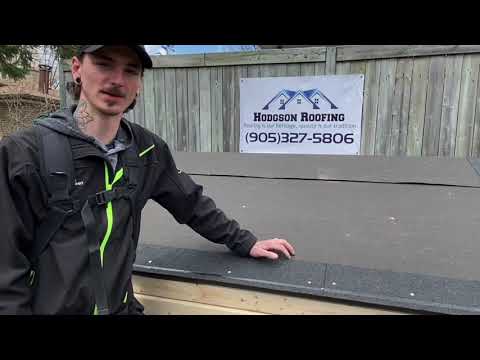Starter shingles are the unsung heroes of a sturdy and long-lasting roof. These remarkable roofing components play a crucial role in safeguarding your home from the harshest weather elements. Designed to be installed at the eaves and rake edges of your roof, starter shingles provide an essential first line of defense against wind-driven rain, ice dams, and even pesky critters seeking entry. But what sets these shingles apart from the rest? Their unique adhesive strip ensures a secure bond, preventing uplift during intense wind events. This means you can rest easy knowing that your roof is fortified against the fiercest storms Mother Nature can muster. Additionally, starter shingles offer a visually appealing finishing touch, ensuring a clean and polished appearance for your entire roofing system. With their exceptional durability, ease of installation, and ability to enhance the overall performance of your roof, starter shingles are an essential investment for any homeowner seeking both protection and aesthetic appeal. Don’t let your roof be left vulnerable – give it the strength and resilience it deserves with top-notch starter shingles.

Starter Shingles: Enhancing the Foundation of your Roof
| Feature | Description |
|---|---|
| 1. Purpose | Starter shingles, also known as starter strips or starter courses, are the foundation of any well-installed roofing system. They are specifically designed to provide a secure base for the first row of shingles, ensuring optimal protection against water infiltration and wind damage. |
| 2. Material | Typically made from asphalt or fiberglass, starter shingles possess exceptional durability and flexibility, allowing them to adapt to various roof configurations. They are engineered to withstand harsh weather conditions and protect the vulnerable edges of the roof from moisture and wind uplift. |
| 3. Adhesive Strips | Many modern starter shingles feature self-sealing adhesive strips, which facilitate a secure bond between the starter course and the subsequent shingles. This adhesive layer prevents water from seeping under the shingles, enhancing the overall waterproofing of your roof system. |
| 4. Installation | Starter shingles are installed along the eaves and rakes of the roof, serving as a protective barrier against ice dams and wind-driven rain. They are typically applied horizontally, perpendicular to the roof edge, and overlapped by the first row of full-sized shingles to provide a seamless transition. |
| 5. Benefits | Using starter shingles offers several benefits, including improved wind resistance, enhanced waterproofing capabilities, and increased longevity of the overall roofing system. They also provide a neater appearance to the roof’s edge, giving it a polished and professional finish. |
Title: Easy Steps for Installing Starter Shingles
What Are Starter Shingles?
When it comes to roofing, there are various types of shingles available, each serving a specific purpose. Starter shingles are an essential component of any roofing system, playing a crucial role in protecting your home from water damage and ensuring the longevity of your roof.
The Purpose of Starter Shingles
Starter shingles, also known as starter strips or starter courses, are the first row of shingles installed at the eaves and rakes of a roof. Their primary function is to provide a solid foundation for the rest of the shingles and prevent water infiltration at the edges of the roof. These shingles are specifically designed to create a seal and protect vulnerable areas from wind-driven rain.
Key Features of Starter Shingles
Durable: Starter shingles are typically made from the same material as the primary roofing shingles but are often reinforced to withstand harsh weather conditions.
Adhesive Strip: Most starter shingles have an adhesive strip along the bottom edge. This strip helps to create a tight seal and prevent wind uplift, ensuring the shingles remain firmly in place.
Correct Size: Starter shingles are manufactured in a specific size that allows for proper overhang and alignment with the subsequent rows of shingles. They are usually wider than regular shingles and may have pre-cut tabs for easy installation.
Installation Process
Proper installation of starter shingles is crucial to ensure their effectiveness in protecting your roof. Here is a step-by-step guide to installing starter shingles:
Step 1: Clean the roof surface thoroughly, removing any debris or old shingles.
Step 2: Install an ice and water shield along the eaves of the roof, extending at least 24 inches past the interior wall line. This provides an additional layer of protection against water infiltration.
Step 3: Place the starter shingles along the eaves, ensuring they overhang the edge of the roof by about 1/4 to 3/8 of an inch. Secure them with roofing nails, making sure to follow the manufacturer’s guidelines for spacing and placement.
Step 4: Continue installing the remaining rows of shingles, overlapping them over the starter shingles to create a watertight barrier.
The Importance of Starter Shingles
Many homeowners may overlook the significance of starter shingles, assuming that regular shingles alone are enough to protect their roof. However, neglecting to install starter shingles can lead to various issues:
Inadequate Protection: Without starter shingles, the edges of your roof become vulnerable to water infiltration, which can lead to leaks, rot, and structural damage over time.
Wind Damage: Starter shingles with adhesive strips help keep the subsequent shingle rows securely in place, preventing wind uplift and potential roof damage during storms.
Increased Lifespan: By providing a proper foundation and enhanced protection, starter shingles contribute to the longevity of your overall roofing system. They help prevent premature aging and deterioration of the primary shingles.
Conclusion
Starter shingles are an essential part of any roofing project, ensuring the integrity and longevity of your roof. They provide a solid foundation for the rest of the shingles and protect vulnerable areas from water damage. Installing starter shingles correctly is crucial to reap their benefits and safeguard your home from potential issues. So, when it’s time to invest in a new roof or replace your existing one, make sure to include starter shingles in your roofing system.

